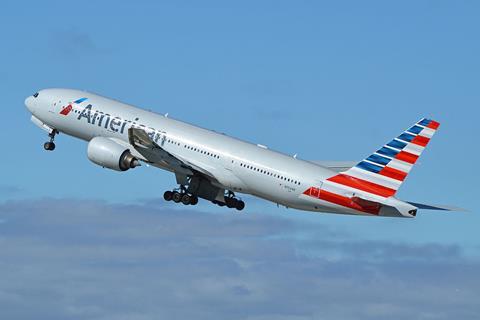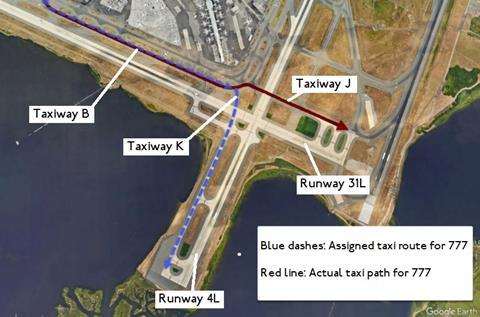US investigators have disclosed that an American Airlines Boeing 777-200ER crew had originally expected and briefed for a different runway departure, and was dealing with a belated load close-out, before a serious runway incursion incident at New York JFK last year.
The crew of the 777 had briefed to taxi for runway 31L ahead of the flight to London Heathrow on 13 January 2023.
But while parked at the gate the crew received instrument clearance – via the ACARS communication system – which indicated a take-off from runway 4L. The crew reprogrammed the flight-management system and revised the taxi briefing, which would take the aircraft along a path similar to the 31L taxi route.
“All three pilots said [during interviews] they understood at that time that [the 777] would be departing runway 4L,” states the National Transportation Safety Board in newly-released human factors and operational documentation on the incident.
After the 777 was pushed back, it was given taxi clearance to runway 4L via a left turn on taxiway B and told to hold short of taxiway K. The crew responded, acknowledging the hold-short instruction.
The inquiry’s documentation reveals that the captain had still not received the load close-out – which contained final confirmation of passenger numbers, fuel and cargo weights – after the pushback, and he slowed the taxi.
He testified to investigators that he would normally have stopped the taxi altogether, but he did not want to hold up traffic, and the presence of a relief first officer meant the close-out could be requested while taxiing.
The relief first officer stopped listening to ground-control communications and used a radio panel to call a company operations agent for the close-out details.

Air traffic control recordings indicate the crew received a ground-control clearance to cross runway 31L at taxiway K – an instruction which would have involved turning right onto K, then crossing runway 31L, and travelling parallel to runway 4L along its western side to the departure point.
The first officer confirmed the instruction, although she thought the clearance was a little early, because the aircraft was still some 5,700ft from taxiway K.
As the jet continued to taxi the relief first officer was still waiting for the close-out via ACARS, which had been delayed by cargo. The crew did, however, receive three ACARS weather messages warning of turbulence.
The close-out was transmitted to the crew about 2min before the incursion, as the first officer was making an announcement to cabin crew, followed by updated zero-fuel weight and centre-of-gravity data to the flight-management system.
As the aircraft approached taxiway K, the first officer was performing crosschecks on take-off performance calculations with the confirmed load close-out data. She was using a handheld tablet which had been showing the airport diagram, but this was not visible after the performance calculation application was opened.
“The captain recalled that he was conferring with the [first officer] about the take-off performance numbers as the [aircraft] approached taxiway K,” says the inquiry documentation.

Instead of turning right onto taxiway K, as instructed, the aircraft continued along taxiway B, a path which would blend into taxiway J and intersect with runway 4L.
“The first officer recalled being head-down and talking about take-off performance numbers as the captain turned toward a runway,” says the inquiry.
“She recalled hearing the captain say, ‘Cleared to cross.’ She recalled looking up, leaning forward, gazing down the runway to the right, and checking the runway and the final approach area for conflicting traffic. She recalled seeing no [aircraft] on the runway.”
The aircraft was crossing 4L on which a Delta Air Lines Boeing 737-900ER, bound for Santo Domingo, had commenced its take-off roll a few seconds earlier.
This triggered an alarm in the control tower from the airport surface-movement radar system and, 5s later, the controller cancelled the 737’s clearance. The 737 crew responded immediately that they were rejecting the take-off.
The 777 captain testified to the inquiry that he saw red lights illuminate as the jet crossed the centreline of the runway and, uncertain as to the reason for the lights, he applied thrust to quicken the crossing and vacate the runway.
Investigators have yet to draw final conclusions over the circumstances of the incursion.
Charts for JFK did not have any ‘hot spots’ – areas of potential confusion or hazard for taxiing aircraft – indicated on the date of the incident. But a ‘hot spot’ amendment was subsequently introduced on 15 June last year, warning crews to maintain vigilance in the vicinity of taxiways K and J, close to runways 4L and 31L.


























